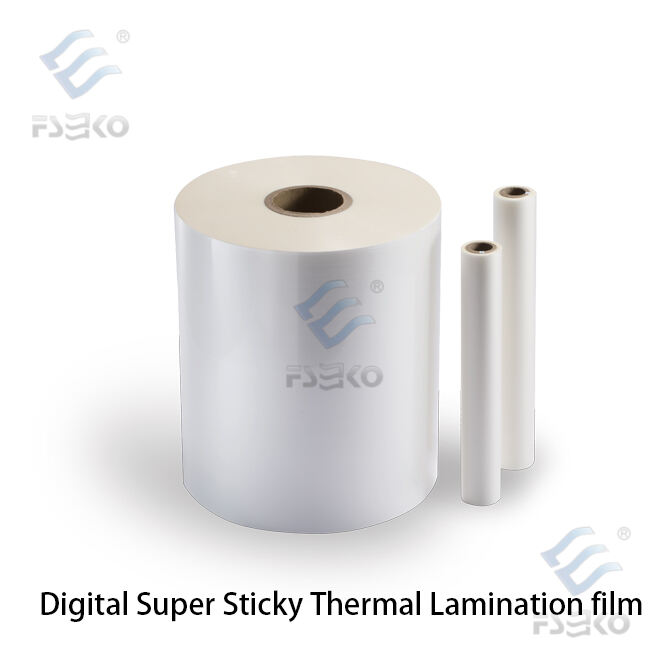Understanding Digital Thermal Lamination Matt Film
Core Components and Functionality
Digital thermal lamination involves the use of a heat-activated adhesive applied to a film, which is then bonded to various substrates to create a durable finish. This process relies heavily on three key components: the matt film, heating elements, and the substrate like paper or card stock. The effectiveness of this lamination technique is largely dependent on the precise temperature and pressure settings. Manufacturers typically provide detailed specifications to ensure optimal adhesion, allowing users to achieve the best possible results.
Applications in Modern Printing Processes
Digital thermal lamination has found its niche in numerous modern printing processes, particularly in packaging where enhancing the visual appeal and increasing the durability of products is essential. It is frequently employed in creating marketing materials, such as brochures and catalogs, which require a professional and polished finish to attract attention. The versatility of digital thermal lamination allows its application across various industries, including graphic design and retail. It helps in promoting brand identity, making products more appealing and reinforcing the brand image in the consumer market. By integrating this technique, companies can deliver high-quality, visually striking materials that stand out from the competition.
Key Advantages of Digital Thermal Lamination
Enhanced Durability and Scratch Resistance
Digital thermal lamination significantly improves the durability of printed materials by protecting them from scratches and moisture damage. Studies show that laminated surfaces resist wear and tear more effectively than non-laminated counterparts, thereby preserving the color vibrancy and aesthetic appeal over time. This durability is particularly advantageous in environments where materials are frequently handled, such as high-traffic areas or retail spaces, ensuring that printed products maintain their quality appearance even under intensive use.
Cost-Effectiveness for High-Volume Projects
For businesses dealing with high-volume printing, digital thermal lamination offers a cost-effective solution by reducing material waste and optimizing production efficiencies. As production scales up, the cost per unit decreases, making this method highly suitable for bulk orders such as brochures, catalogs, or packaging. Numerical data supporting this can highlight significant savings, reaffirming the economic benefits of choosing digital thermal lamination for sizable printing projects, thus maximizing cost-effectiveness in large-scale operations.
Versatility Across Printing Substrates
Digital thermal lamination caters to a wide array of printing substrates, including plastic, paper, and cardstock, showcasing its versatility and adaptability across different materials. This flexibility allows businesses to tailor their printed materials without compatibility worries, enhancing the customization potential for varied applications. Empirical evidence confirms that thermal lamination successfully adheres to multiple surface textures and types, ensuring a broad applicability that supports diverse industry requirements, from retail displays to professional-grade marketing materials.
Limitations and Challenges
Heat Sensitivity Concerns
One of the significant challenges faced in digital thermal lamination is the sensitivity of certain substrates to heat. This process involves applying heat to laminate materials, but improper heat settings can cause adverse effects such as curling or warping, particularly on delicate substrates. For instance, when materials are subjected to excessive heat, the integrity of the printed layouts can be compromised, causing distortions that impact the quality of the end product. To address this issue, industry standards have established recommended heat settings that allow for better control. These standards are designed to mitigate the risks associated with heat sensitivity, but they also require careful attention and possibly more manual intervention during the lamination process.
Application Skill Requirements
The successful application of digital thermal lamination is not just a technical task. It often demands specialized skills and experience to ensure optimal results. Much like mastering a craft, training and experience play vital roles in overcoming the initial learning curve associated with this technology. Techniques such as proper alignment and speed control need to be mastered to achieve a uniform finish while minimizing defects like air bubbles or wrinkles. In commercial settings, these skills are crucial as they directly impact the quality and efficiency of production. Therefore, investing in training for personnel can lead to significantly improved outcomes, benefitting the business's bottom line and customer satisfaction.
Environmental Considerations
Concerns about the environmental impact of laminating films are growing, primarily due to the plastic content in these materials and the sustainability issues it raises. Traditional laminating films are often criticized for their long degradation periods, which can take centuries, thus contributing to landfill waste and environmental pollution. As the call for eco-friendly solutions becomes more pronounced, the industry is moving towards developing laminating films that minimize environmental impact. Companies like EKO Film have responded by innovating recyclable and environmentally-friendly laminating products. However, balancing performance with sustainability remains a challenge, as the current eco-friendly options may not yet match the durability and quality of traditional films. Continued research and development are crucial to bridging this gap and providing sustainable yet effective laminating solutions.
Environmental Impact and Sustainable Solutions
Recyclable Film Options
Recyclable films are becoming increasingly available, providing businesses with the opportunity to engage in more sustainable lamination practices. Studies have highlighted that utilizing these recyclable films can significantly reduce plastic waste and lower carbon footprints associated with manufacturing processes. This shift towards sustainability is not only beneficial for the environment but also for businesses seeking to enhance their brand reputation. Earning certifications for sustainability efforts is an added advantage, signifying commitment to eco-friendly practices and appealing to environmentally conscious consumers.
Plastic Reduction Initiatives
As environmental consciousness grows, many companies are adopting plastic reduction initiatives, especially in the realm of laminating films. By transitioning to alternative materials, organizations can vastly decrease their environmental impact while maintaining product durability. These initiatives are reshaping industry standards, with a strong commitment to sustainability influencing both corporate policies and consumer preferences. As companies continue to prioritize eco-friendly solutions, we expect the film industry to innovate towards greener alternatives even further.
Energy-Efficient Application Techniques
Adopting energy-efficient application techniques is crucial to reducing energy consumption in digital thermal lamination processes. The incorporation of advanced technologies, such as LED-activated films, has demonstrated similar levels of durability while consuming less energy. Recent industry reports emphasize the potential for substantial energy savings, highlighting both economic and environmental benefits. As the lamination industry progresses, embracing such technologies will be pivotal in achieving greater sustainability and setting new benchmarks in energy conservation.
Sourcing Quality Lamination Materials
Evaluating Online Suppliers
When sourcing lamination materials, businesses must evaluate online suppliers based on a myriad of factors to ensure quality and reliability. These factors include the supplier's reviews, product offerings, certifications, and their ability to meet performance standards and customer satisfaction. Conducting a comparative analysis of different suppliers can help identify vendors that provide higher-quality materials and services, ensuring optimal performance and durability. Industry experts recommend selecting suppliers that prominently display their performance records and customer satisfaction levels, allowing businesses to make informed purchasing decisions.
Key Specifications for Scratch-Resistant Films
Understanding the key specifications of scratch-resistant films is crucial for making informed purchasing decisions. Critical attributes such as thickness, adhesive type, and the lamination quality standards dictate the film's durability and scratch resistance. Industry standards highlight specific parameters that are essential to guarantee the product's performance and longevity. Ensuring these specifications are met helps achieve maximum effectiveness and extends the lifespan of the materials, adding value for both the supplier and the purchaser. For those interested in new material options like laminating films, the reference information is beneficial ["where to buy laminating film"](https://example.com).
Certification and Compliance Checks
Verifying certifications and compliance with industry standards is essential when procuring lamination materials. This ensures that the materials meet the required safety and performance levels, protecting businesses from potential liability issues. Suppliers should provide documentation about their compliance, promoting responsible purchasing practices. As sustainability concerns grow, companies are increasingly prioritizing suppliers that maintain high standards of quality assurance. This shift underscores the importance of thorough certification and compliance checks in the lamination industry's procurement processes.


